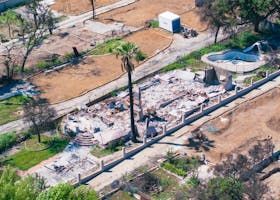The devastating wildfires that erupted across Southern California in January 2025 have fundamentally transformed the region's real estate landscape, creating an unprecedented housing crisis that extends far beyond the burn zones. With over 57,000 acres scorched and more than 16,200 structures destroyed, the immediate aftermath has triggered a perfect storm of supply shortages, surging rental prices, and displaced residents competing for limited housing stock.
Quick Answer: The 2025 Southern California wildfires have intensified an already critical housing shortage, driving rental prices up by 8-20% in affected areas, displacing over 40,000 residents, and creating urgent demand that will reshape real estate markets for years to come. The crisis has transformed what was already a challenging market into a highly competitive environment where cash offers, insurance considerations, and geographic risk assessments now dominate buyer and investor decision-making.
The Immediate Impact: Market Disruption by the Numbers
The scale of destruction from the Palisades and Eaton fires has created market conditions unlike anything Southern California has experienced in recent memory. According to Cal Fire data, the fires have scorched over 57,000 acres and destroyed more than 16,200 structures, with an estimated 10,000 homes completely lost and 40,000 residents displaced. This represents the most destructive wildfire series in Los Angeles history, with implications that extend far beyond the immediate burn areas.
The housing inventory crisis has reached critical levels. Reports indicate that the number of available homes on the market in Los Angeles was already down by 26 percent before the fires, and with the latest destruction, this situation is projected to worsen significantly. Real estate professionals are witnessing unprecedented demand as displaced families flood an already constrained market.
Real estate agents report working 12-to-14-hour days because of the surge in demand, with some areas experiencing "basically no rentals" available. The immediate rental market response has been swift and severe, with Google searches for "Los Angeles homes for rent" jumping 186 percent as of mid-January compared to the first week of the year.
Rental Market Transformation: Price Surges and Availability Crisis
The rental market has become the epicenter of the housing crisis, with dramatic price increases occurring across the region. Rental prices are exploding across the region, with some areas seeing rent climbing hundreds or thousands of dollars a month, depending on the location, size and amenities. The surge varies significantly by location, but the overall trend is unmistakably upward.
Market analysts are tracking rental price increases that range from 8 percent to as much as 20 percent in certain high-demand areas. In San Diego County, renters experienced a 5.5% increase over the past year, the second-largest nationally, while Inland Empire tenants saw a 4.9% increase, ranking it the seventh largest nationally. These increases compound the challenges that were already present in Southern California's rental market.
The supply-demand imbalance has created particularly acute challenges for displaced families seeking immediate housing solutions. Real estate professionals report that "short-term furnished housing" has become the most sought-after commodity, with phones "ringing off the hook" from desperate families needing immediate accommodations. The scarcity of such properties has created a cascade effect throughout the broader rental market.
Geographic Impact Analysis: Beyond the Burn Zones
The wildfire impact extends far beyond the areas directly affected by flames, creating ripple effects throughout Southern California's interconnected housing markets. Neighborhoods completely untouched by fire are experiencing significant influxes of displaced residents, fundamentally altering local market dynamics and pricing structures.
Areas like Altadena, which lost substantial housing stock in the Eaton Fire, were already experiencing gentrification pressures before the disaster. Before the fire, Altadena was gentrifying, and the loss of housing inventory is likely to accelerate these trends as replacement housing commands premium prices. The rebuilding process will likely reshape these communities both physically and economically.
Sacramento real estate professionals report receiving calls from fire victims looking for more affordable options a good 100 miles away from where they used to live, with most people wanting "to be in suburbia, where there was low fire risk, definitely far away from any high or moderate fire hazard areas". This geographic shift represents a significant trend that could reshape regional population distribution patterns.
The displacement has created new demand centers in previously stable markets. Communities in Ventura County, the Inland Empire, and even as far as Orange County are experiencing increased inquiry volumes from families seeking permanent relocation options. This geographic dispersion of demand is creating new competitive pressures in markets that were previously considered more affordable alternatives to Los Angeles proper.
Insurance Crisis: The Hidden Market Disruptor
Beyond the immediate housing shortage, the insurance implications of the wildfire crisis are creating long-term structural changes in the real estate market. The wildfires in L.A. could deepen the insurance crisis in Southern California and may lead to higher insurance costs for homeowners, with insurance companies potentially avoiding unpredictable and unprofitable regions unless higher insurance premiums can compensate for the risk.
The insurance challenge has become a critical factor in real estate transactions. Homeowners insurance has become so expensive, it's already a focal point of buyer-seller negotiations, just like closing costs. This shift represents a fundamental change in how properties are valued and transactions are structured in fire-prone areas.
If premiums are capped by state regulations, expect more uninsured homeowners in California, while buyers may weigh the cost of going without insurance or may choose to live somewhere else altogether as fire risks are front-of-mind. This dynamic is already influencing buyer behavior and investment decisions across the region.
The insurance availability issue is particularly acute for mortgage approvals. Properties in high-risk zones are facing increased scrutiny from lenders, with some transactions falling through when insurance coverage cannot be secured at reasonable rates. This has created a secondary market disruption that compounds the primary housing shortage issues.
Construction and Rebuilding Challenges: Timeline and Market Implications
The rebuilding process faces significant obstacles that will extend the housing shortage crisis well into the future. Restoring the city's lost housing stock is likely to take at least three to five years, according to real estate agents, because of the time it takes to clear the burned homes, reach settlements with insurance companies, work through the permitting process and then find the labor needed to rebuild.
Construction material costs are already responding to increased demand. Remodelers report suppliers have already hiked materials costs by 6.9% so far this year, and this trend is expected to accelerate as rebuilding efforts commence in earnest. The construction labor shortage that predated the fires will be exacerbated by the massive rebuilding effort required.
The permitting and regulatory approval process adds additional complexity to rebuilding timelines. Many property owners face decisions about whether to rebuild in the same locations or sell their lots to developers who might pursue different development strategies. These decisions will ultimately shape the character and density of rebuilt communities.
Some developers and investors are already positioning themselves to acquire damaged properties, though concerns exist about "predatory buyers" who are seeking to take advantage of financial distress among fire victims. This dynamic adds ethical considerations to the rebuilding process and may influence local policy responses.
Investment Opportunities and Strategic Considerations
For real estate investors and professionals, the post-fire market presents both challenges and opportunities that require careful strategic analysis. The fundamental supply-demand imbalance creates potential for appreciation, but geographic and regulatory risks must be carefully weighed.
Real estate professionals anticipate that "any house that was under $2 million was getting 10-20 offers" before the fires, and "now with people shopping with insurance money, it's going to get distorted significantly". This suggests that competitive dynamics will intensify, particularly in the sub-$2 million market segment where displaced homeowners are seeking replacement properties.
The rental investment market presents particularly compelling opportunities, given the acute shortage of rental housing and the likelihood of sustained high demand. Properties in areas with lower fire risk but reasonable commuting access to employment centers are positioned to benefit from the geographic shift in housing demand patterns.
However, investors must carefully consider insurance costs and availability in their financial modeling. Properties in moderate-risk zones that were previously considered safe investments may face new scrutiny from insurance providers, affecting both rental yields and exit strategies. Due diligence now requires comprehensive wildfire risk assessment and insurance cost projections.
Multi-family properties and apartment complexes are particularly attractive given the rental shortage, but zoning and development restrictions may limit new supply additions. Investors with existing rental properties in stable markets may benefit from natural appreciation and improved cash flow dynamics.
Economic Ripple Effects: Regional Market Interconnections
The wildfire impact extends beyond residential real estate into commercial markets and broader economic patterns. With apartment vacancy rates below 5%, the Los Angeles County real estate market was already tight, and as the fires exacerbate the supply-demand imbalance, local rents should rise further. This tightness affects business operations and employment patterns throughout the region.
Commercial real estate markets are experiencing secondary effects as businesses relocate employees or adjust operations to accommodate housing challenges. Some companies are offering housing assistance or temporary relocation packages, creating new demand patterns in markets outside the immediate fire zones.
The economic implications extend to municipal budgets and infrastructure planning. Communities receiving displaced residents must accommodate increased demand for services, schools, and infrastructure without corresponding increases in tax base or planning preparation. This creates fiscal pressures that may influence future development policies.
As noted by USC researchers, "a tightly constrained housing supply reduces resilience to absorb losses from unexpected disasters," and "in Los Angeles, this lack of flexibility could rapidly intensify gentrification as relocations strain the existing housing stock". This observation highlights the systemic nature of the housing challenge beyond the immediate fire response.
Long-term Market Predictions and Scenarios
Looking ahead, multiple factors will shape the evolution of Southern California's real estate market over the next several years. The interplay of rebuilding timelines, insurance market adjustments, and regulatory responses will create distinct phases of market development.
Optimistic Scenario (2025-2027): Rapid insurance market stabilization, streamlined permitting processes, and increased construction capacity could accelerate rebuilding efforts. In this scenario, the acute housing shortage begins to ease by late 2026, with rental price growth moderating to more sustainable levels. New construction incorporating fire-resistant materials and design could enhance property values in rebuilt areas.
Base Case Scenario (2025-2028): The most likely scenario involves a gradual rebuilding process extending through 2028, with housing shortages persisting through 2026-2027. USC forecasts suggested Southern California apartment rents would increase 2-4% annually through 2025 under normal conditions, but post-fire dynamics are likely to push increases above these projections in affected markets.
Pessimistic Scenario (2025-2030): Extended insurance market disruption, regulatory delays, and continued climate-related disasters could prolong the housing crisis. In this scenario, affordability challenges intensify, accelerating out-migration from Southern California and creating long-term demographic shifts.
Climate considerations will increasingly influence long-term property values and development patterns. Federal Reserve research indicates that "property values have been more adversely impacted in recent years by being close to past wildfires than was the case previously", suggesting that proximity to fire risk will become a more significant valuation factor going forward.
Strategic Guidance for Different Market Participants
For Homebuyers: The current market requires exceptional patience and financial flexibility. Cash offers have become increasingly important, and buyers must factor insurance costs into their total cost of ownership calculations. Consider properties in lower-risk geographic areas that still provide reasonable access to employment centers. Pre-approval processes should include insurance cost verification to avoid transaction failures.
For Real Estate Professionals: The market demands enhanced expertise in wildfire risk assessment, insurance navigation, and alternative housing solutions. Professionals who develop specialized knowledge in fire-damaged property transactions, insurance claim processes, and temporary housing arrangements will find increased demand for their services. Building relationships with insurance professionals and construction contractors becomes essential.
For Investors: Focus on properties in lower-risk areas with strong rental demand fundamentals. Multi-family properties and single-family rental investments in stable communities position to benefit from displaced resident demand offer compelling opportunities. However, comprehensive due diligence must include wildfire risk mapping, insurance cost analysis, and exit strategy planning that accounts for climate-related risks.
For Current Homeowners: Property owners in fire-prone areas should proactively review insurance coverage, consider property hardening investments, and develop evacuation and document protection plans. Those in unaffected areas may benefit from refinancing opportunities if property values appreciate due to increased demand from displaced buyers.
Regulatory and Policy Considerations
Government response at multiple levels will significantly influence market evolution. California authorities have warned that the current situation might lead to price gouging in the Los Angeles rental market and have cautioned real estate agents against taking advantage of vulnerable residents. Regulatory enforcement and new policy measures are likely to emerge.
Zoning and development policy changes could facilitate increased density in rebuilding areas, potentially improving long-term housing supply. However, political and community resistance to density increases may limit the effectiveness of such measures. The tension between fire safety requirements and housing density needs will require careful policy balancing.
State-level insurance regulation may evolve to address market failures in high-risk areas. While the California Department of Insurance has passed legislation requiring insurers to continue covering at-risk zones, insurance costs in those areas will be higher than what they were in the past. Further regulatory intervention in insurance markets could significantly impact property values and investment returns.
Federal disaster relief and rebuilding assistance programs will influence the pace and character of recovery efforts. The availability and terms of federal support could determine whether rebuilding occurs at previous density levels or incorporates more fire-resistant but potentially more expensive construction approaches.
Technology and Innovation Responses
The crisis is accelerating adoption of technology solutions for risk assessment, property management, and construction processes. Advanced wildfire risk modeling is becoming standard in property valuation and investment analysis. Satellite monitoring, weather prediction systems, and fire behavior modeling are increasingly integrated into real estate decision-making processes.
Construction technology innovations focused on fire resistance are gaining market attention. Properties incorporating advanced fire-resistant materials, defensible space design, and smart home fire detection systems may command premium pricing and improved insurance terms. These technological advances could create new property value differentials within the market.
Property management technology is evolving to address evacuation planning, tenant communication during emergencies, and rapid property condition assessment following disasters. These capabilities are becoming competitive advantages for property management companies and could influence tenant retention and rental pricing.
Frequently Asked Questions
How long will the Southern California housing shortage last after the wildfires?
The acute housing shortage is expected to persist for 3-5 years based on rebuilding timelines. The immediate rental shortage may begin to ease in 2026 as temporary housing solutions are developed, but full market recovery requires completing the rebuilding process, which involves insurance settlements, permitting, and construction phases that typically extend several years.
Are rental prices likely to stabilize or continue increasing?
Rental prices are expected to continue increasing above normal rates through 2026-2027. While pre-fire forecasts suggested 2-4% annual increases, the current supply shortage is driving increases of 8-20% in affected markets. Stabilization depends on new construction completion and the resolution of insurance market disruptions.
Which areas of Southern California offer the best investment opportunities post-fire?
Areas with lower wildfire risk but good access to employment centers present the strongest opportunities. This includes parts of Orange County, stable Inland Empire communities, and Ventura County locations. Multi-family rental properties in these areas benefit from displaced resident demand while avoiding the highest insurance and rebuilding risks.
How should insurance considerations change real estate investment strategies?
Insurance costs and availability must now be primary factors in investment analysis. Properties should be evaluated based on wildfire risk mapping, insurance cost projections, and carrier availability. Investors should build insurance cost escalation into financial models and consider insurance availability as an exit strategy risk factor.
What government assistance is available for displaced residents and property owners?
Federal disaster declarations provide access to FEMA assistance for temporary housing and rebuilding support. California state programs offer additional resources for displaced residents. Property owners may qualify for tax relief and streamlined permitting processes. However, demand for assistance exceeds available resources, requiring early application and patience with processing timelines.
Conclusion: Navigating the New Reality
The 2025 Southern California wildfires have created a watershed moment for the region's real estate market, transforming an already challenging housing landscape into a crisis that will reshape communities for years to come. The immediate impacts of massive displacement, acute rental shortages, and surging prices represent just the beginning of a longer-term market evolution that will require adaptation from all participants.
The data clearly indicates that this crisis extends far beyond the burn zones, creating ripple effects throughout Southern California's interconnected housing markets. With rental prices increasing 8-20% in affected areas and over 40,000 residents seeking alternative housing, the supply-demand imbalance has reached unprecedented levels that will take years to resolve.
For real estate professionals, investors, and residents, success in this transformed market requires embracing new approaches to risk assessment, financial planning, and strategic decision-making. The integration of wildfire risk analysis, insurance cost modeling, and geographic diversification strategies has shifted from optional considerations to essential requirements for market participation.
While the challenges are significant, opportunities exist for those who adapt quickly to the new market realities. Properties in lower-risk areas with strong rental fundamentals, innovative approaches to insurance and risk management, and strategic positioning for long-term demographic shifts can provide compelling returns for informed investors and professionals.
The path forward requires balancing immediate crisis response with long-term strategic planning, recognizing that the post-fire Southern California real estate market will operate under fundamentally different conditions than existed before January 2025. Success will belong to those who understand these new dynamics and position themselves accordingly for the challenges and opportunities ahead.











